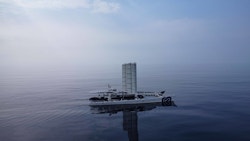The beauty of slowing down
1,800 miles, that’s the distance we are sailing from Kochi, our last stopover in India, to Seychelles.
India has been home to Energy Observer for some weeks, it is a magical country, incredibly dynamic, which runs at the fastest speeds and made us run at the same rhythm but now, after two weeks of sailing and in the middle of the Indian Ocean we are confronted to a completely different reality: slowness.

Our boat has had different lives. Originally a racing catamaran built to break the speed records, and today a laboratory vessel whose goal is completely different. When we invite people onboard, we often get the same question: how fast is the boat? And when we reply that our average speed is 5 knots, meaning 9 km/h, or the speed of an athlete running a marathon, people stare at us with a surprised look. To put it into perspective, the cargo ships we cross, the giants of the sea, easily reach 20 knots, going at speeds which are four times ours. You’d be surprised to know that in most cases we sail much slower than most of the marine animals too. A swordfish, for instance, has a peak speed of around 100 km/h and could travel these 1700 miles much quicker than us: a couple of days versus 18 days for us.
It is slow indeed, and as of today we are not used to go slow at the point that slowness can be seen as a downside. But it isn’t, on the contrary, it can help us acknowledge the value of natural resources, the importance of responsibly consuming energy, and most of the times it can even be beautiful.

A bigger picture of reducing speed at sea
Most of the items we buy online come from the opposite side of the world, travelling miles and miles by sea up to our doorstep. With a simple click we move a whole fleet and we ask it to be as fast as possible. Not a problem when you have conventional fuels, the fastest you want to go, the more power you will need to ask your engines, the greater the amount of fuel you will need to embark. In short, you need power, you burn your fuel. That’s a simple equation, but that doesn’t come with no issues. Let’s put it into numbers. 250 to 300 million tons is the amount of fuel consumed every year by all merchant vessels going around our oceans: a dramatic source of pollution which is urgent and - I personally think - possible to reduce.
The momentum around new alternative fuels is high: hydrogen, ammonia and methanol are all valid option which are essential to preserve the environment. Yet, there is a much simpler and immediate solution to start this transition: speed reduction and optimisation. A slower ship demands less fuel. In fact, lowering speed by 20% not only would allow to limit underwater acoustic pollution thanks to smaller helices cavitation but would also result in a 24% carbon emissions reduction. That’s the easiest and cheapest way to reduce emissions. That’s not the end of the story, operating below the nominal power cuts fuel consumption and thus operational costs too, representing a huge economic advantage to all freight forwarders.
Depending on natural elements
We are not an ordinary boat: we need the sun to shine on our photovoltaic panels, the wind to hit our OceanWings and the current to flow in a good direction. We depend on nature, and we cannot go where we want as fast as we want just burning a fuel. This clearly reflects into our journey and behaviour and makes the whole crew and myself acknowledge that energy is not for free and, more importantly, is incredibly valuable. If we want to reach our destination on time, we need not only to quest after the elements, but we also need to be flexible, adapt and find solutions.
Onboard, speed and energy management are strictly linked, the goal being pursuing a balance between our production and our consumption - if not instantaneously, at least on a daily basis. When natural elements are on our side all this is quite smooth, but some other times, when the amount of energy we have at our disposal is limited, sailing becomes a real challenge. Saving energy becomes crucial to be able to successfully get to the finish line of each of our navigations, this means adapting the route and slowing down.
There are days in which we eat salads to avoid using the stoves, days in which we decide to switch off one of our fridges and to cut the power supply to all plugs for some hours to save energy. We understood that we can cook pasta without boiling it, that fans consume less than air conditioning and that if we put the power needed to bake bread into our engines, we could gain a couple of knots.
At home we are used to the comfort of being connected to the grid: when our laptop is out of charge we plug it in, when we want to drink a coffee we switch on the coffee machine, we find it tough to work without air conditioning during summer. All these habits demand energy and somewhere around the country or even the entire world this energy is produced, impacting the environment and polluting the atmosphere. I challenge you to measure how much energy you consume every day and to set a limit to it. Every kWh counts, as we say onboard. One kW may not make the difference instantaneously but at the end of the day, the sum of all the kW that you used can change the picture.
Going slow comes with some advantages too : we learn at every moment how energy is essential in our lives and how often we take it for granted, we have the time to observe all the beauty around us, animals get closer to us, dolphins plays with the bows at the front of the boat, we enjoy the sunrises and sunsets and we take advantage of the whole trip sometimes even losing the sense of time.
Slowing down is not simple, especially in the fast-moving world we live in, it requires a change of mindset and some efforts too. It is becoming urgent to slow down, and the best energy is the one we do not use, on board our laboratory vessel as well as in our daily life in general.
But we have no choice, it is essential to protect the environment and, to be honest, is not bad at all.